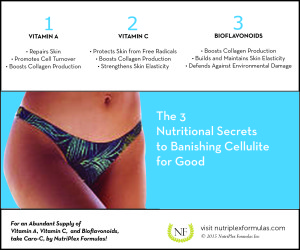 Lean and fit or overweight and out of shape, cellulite plagues so many women (and some men as well). While there seems to be a million and one physical exercises, cosmetic procedures, and creams that claim to get rid of it, without proper nutritional support, the cellulite sufferer is bound to keep suffering.
Lean and fit or overweight and out of shape, cellulite plagues so many women (and some men as well). While there seems to be a million and one physical exercises, cosmetic procedures, and creams that claim to get rid of it, without proper nutritional support, the cellulite sufferer is bound to keep suffering.
Why?
Because, cellulite is the result of weakening connective fibers beneath the skin. Cellulite is the result of this tissue losing its elasticity. So, when you’re trying to rebuild those tissues, you have to provide them with the right nutrition to do so. Just like muscles, where you need to feed them protein to grow, connective fibers need vitamin A, vitamin C, and bioflavonoid foods to rebuild and produce collagen.
It’s absolutely necessary to create collagen if you’re looking to get rid of cellulite, as collagen is the protein that rebuilds connectivity fibers and thereby strengthens skin elasticity.
And while it’s a great idea to firm up muscles and reduce fat through physical exercise, building muscle is a process that requires the destruction and reconstruction of tissues – and to rebuild anything, the body requires proper nutrition. For muscles, it’s protein and calcium; for skin it’s the combined effect of vitamin A, vitamin C and bioflavonoids.
Take a closer look at these three nutrients for an explanation as to how they work to banish cellulite:
Vitamin A
Perhaps the ultimate skin vitamin, vitamin A is used for a range of conditions from acne to psoriasis. Prescribed in a number of forms, it fuels cell turnover and increases collagen production, giving the skin strength and structure.
Vitamin C
Vitamin C is regarded as one of the best vitamins for fighting cellulite because it also plays a huge role in collagen production and is necessary for building strong connective fibers. It also works to protect skin tissues from free radicals that contribute to aging and stall cell turnover.
Bioflavonoids
Often lauded for their anti-aging effects, bioflavonoids defend the skin from environmental damage, which not only produces wrinkles but also weakens skin elasticity. As such, bioflavonoids are another key nutrient needed for collagen production, and the building and maintenance of skin elasticity.
As we age, the damages sustained from stress, pollution, diet, and so on are reflected more clearly in the skin, and they take longer to repair on their own, if they ever do. Because cellulite is a direct result of this lingering damage, which includes the weakening of skin tissues and their elasticity, it’s necessary to fill up on the nutrients – namely vitamins A and C and bioflavonoid foods – that will support, build, and repair them.
—-
For a safe, whole-food source, full of vitamin A, vitamin C, and bioflavonoids, take Caro-C, by NutriPlex Formulas.
Sources:
http://www.livestrong.com/article/186910-vitamins-that-help-cellulite/
http://www.lifeextension.com/magazine/2012/11/Bioflavonoids_Create_Youthful_Skin_Tone/Page-01
http://www.healwithfood.org/cellulite/diet.php
http://chriskresser.com/nutrition-for-healthy-skin-part-1/
http://abcnews.go.com/Health/Wellness/15-myths-facts-cellulite/story?id=20385765#6
